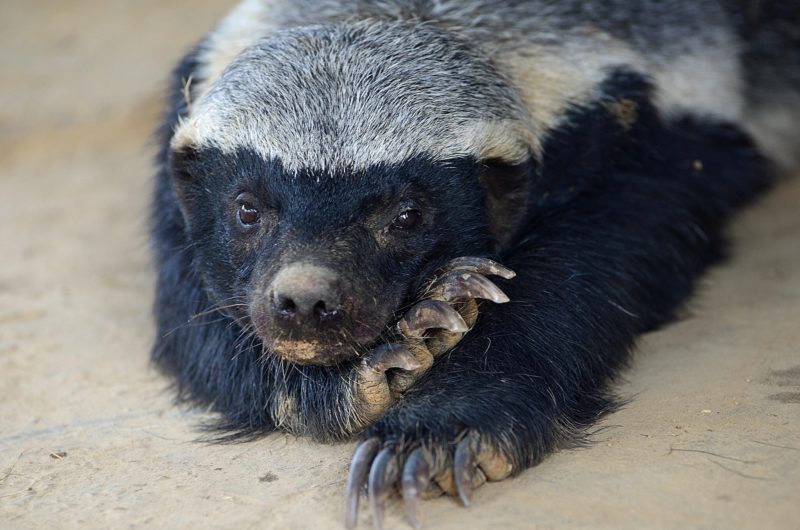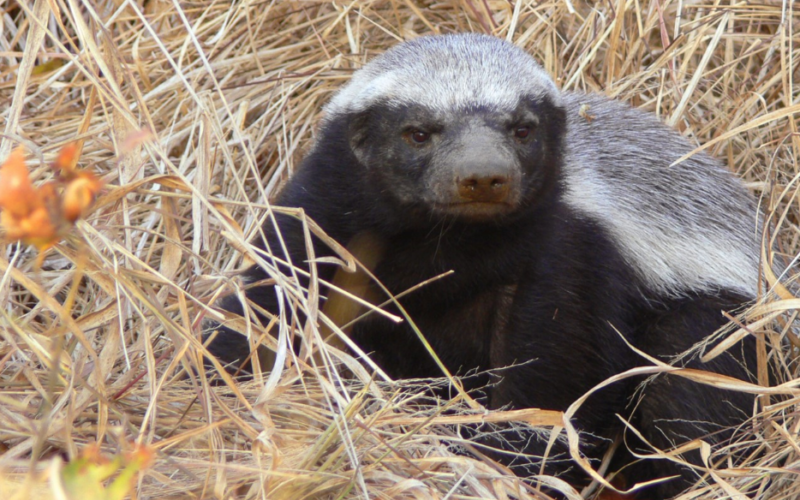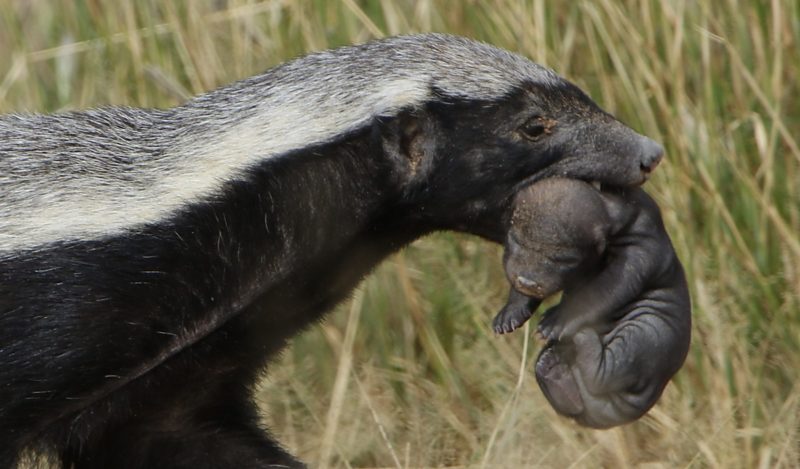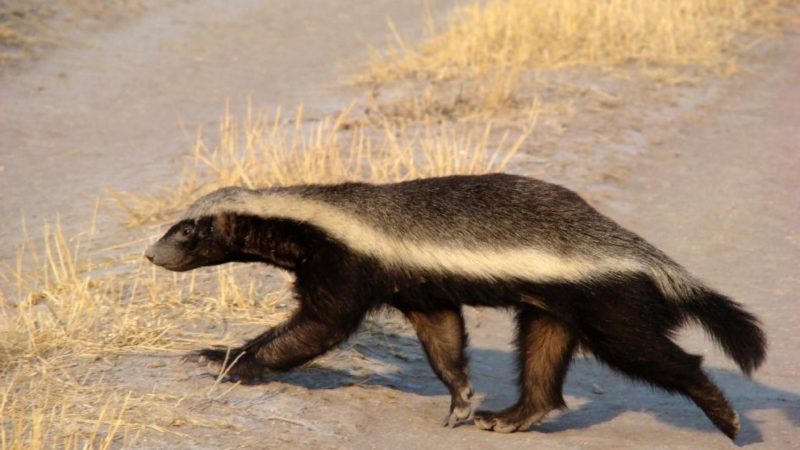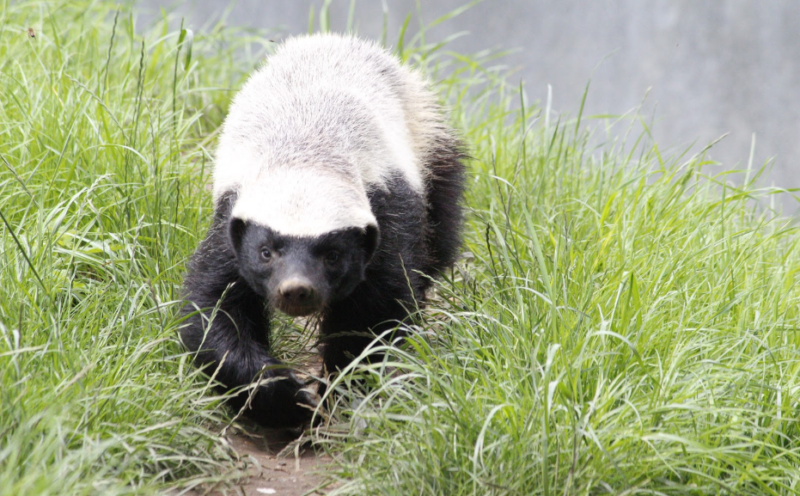Outwardly, this creature resembles the small size of a charming and harmless teddy bear. I can’t believe that this cute looking animal is considered one of the most fearless and aggressive predators on the planet. And yet, this is so. Badger-honey badger is a champion in the number of terrible and bloody fights, out of which he is almost always a winner.
Material Content:
Description and habitat of honey badger
A honey badger (in the scientific classification of Mellivora capensis), also called a bald badger, or a warrior, is a representative of the marten family, a predator that has no equal on earth.
- His body grows about 70 - 90 cm in length and 30 cm at the withers with a weight of about 15 kg.
- The tail length is about 20 cm.
- The upper part of the head of the back and tail of the animal is painted in dark color, while the lower part of the body is light (in summer it brightens even more).
A distinctive feature of this animal is a very hard thick skin, which at the same time remains quite loose, which explains the unusual resourcefulness of the animal. Due to this feature, a badger can easily dodge the enemy grabbing it from behind and dig into it with sharp teeth and claw blades.
The teeth of this animal are very sharp, and the jaws are powerful, so he can crush and tear almost any part of the game he caught, including the bones and even the shells of turtles.
Externally, the honey badger is a bit like a skunk because of its black and white color. The similarity does not end there - the badger also has a peculiar anal sac, which emits a strong pungent smell.This feature helps him to frighten large predators.
The honey badger lives in the desert areas of Asia and Africa, the Arabian Peninsula and India. At the same time, in Africa, these animals choose the hollow of trees for housing, in Asia, they dig burrows on their own.
The nature and lifestyle of the animal
Badger-honey badger - the record holder of the Guinness book. He is brought into it as the most fearless beast on the planet. This animal easily fights with predators, which are several times larger than its size: lions, leopards, monitor lizards. The structural features of the skin of this animal make it very dexterous, and therefore it is extremely difficult for a predator to kill a honey badger. In the heat of battle, the badger bites into the victim's body and often the badger has absolutely no chance of salvation.
In addition to fearlessness, badgers are also distinguished by remarkable intelligence and observation. In the process of hunting, these animals use many options for catching prey. So, naturalists have repeatedly noted how a badger, in order to get to the hive with honey, moves a log or stone to the tree.
Honey badgers lead a mostly nocturnal lifestyle, getting enough sleep in a hollow or hole during the day. The depth of a dug hole can reach 3 m and often such dwellings form a whole town. The badger climbs trees very well, but climbs them only when it wants to feast on the honey of wild bees.
Medoedov is distinguished by a characteristic gait: the beast presses the body to the ground and bends its back. These animals are able to travel quite long distances, galloping. An angry badger is able to catch up even with a cheetah sprinter record holder.
Honey badger is a lone beast in contact with its own kind exclusively during the mating season.
What does the animal eat?
The rodent's diet includes various rodents: hamsters, rats, mice. The badger does not disdain also turtles, hedgehogs, lizards, frogs, insects, birds and even small crocodiles, occasionally - plants and berries.
It is interesting. A honey badger can easily digest snakes, even the most poisonous, such as cobra or viper, and individuals living in the vastness of Asia can even eat a scorpion.
After snakebites, a badger behaves truly unique. For some time, from a few minutes to an hour, the animal can fight in terrible convulsions. From the side it may seem that the badger is about to die in terrible torment. After convulsions, he calms down for a while, and then rises and sets off for his business. Scientists still can not give an accurate explanation of this phenomenon of the bald badger.
The tactile, sight and hearing of the warrior is truly impressive - he can smell his prey, located at a depth of 1.5 m underground. The badger immediately begins to dig up the soil with its powerful paws and strangles the victim.
But the favorite delicacy of this variety of badger is, of course, honey, thanks to which the animal got its name. In fairness, it should be noted that he does not very often feast on his warrior. In the process of hunting for a beehive of wild bees, a bird helps him, nicknamed the honey pointer. As the name implies, she points the badger to the location of the hive with a specific whistle. Following the bird on the ground, the warrior discovers a hive, ruins it and regales it with honey, while the honey-pointing bird picks up the larvae of bees. Both, the mammal and the feathered, are quite pleased with this collaboration.
Saturated with honey or rodents, the bald badger goes on vacation to a hole or a hollow.
The mating season and care for offspring
Single badgers form pairs exclusively during the mating season, which usually begins in September - October (although they can mate throughout the year). After fertilization, the male leaves the female and returns to his site. Six months later, badgers born 1 - 3 cubs.The first 2 weeks, the babies do not leave their home, and the female jealously guards them from a possible attack by predators.
Young badgers stay with their mother, who teaches them how to get food for up to a year. Upon reaching this age, they leave her home and enter an independent life.
Life span
Despite close monitoring by naturalists of the warder, it was not possible to establish and officially fix the life expectancy of these animals in the wild. According to some sources, this figure can reach 8 - 10 years.
Captive bald badgers can reach the age of 25 years. However, individuals contained in zoos are very difficult to reproduce.
Natural enemies
In view of its fearlessness, sharp claws and powerful jaws, the honey badger does not have many enemies. Its main enemies are wild dogs and wolves. Even lions try to avoid the fearless warrior, although some of them can prey on a badger. However, this is extremely rare and most often individuals expelled from the pride or wounded animals desperate from hunger encroach on the life of the honey badger.
Honey badger and man
Relations with a man at a bald badger are quite tense. Due to the lack of food, this predator can undermine the chicken coop and, having penetrated into it, destroy all the hens. In the wild, the animal is afraid of the two-legged and tries not to appear in their path.
However, the inhabitants of Africa and some parts of Asia may meet this fearless creature, and then the advantage may not be on the side of man. After all, the skin of a badger is not sensitive to arrows, and even the sharpest machete is not able to penetrate this shell.
Travelers are advised to try to get around places of a possible meeting with a honey badger.
And if a curious tourist could not avoid a collision with the warrior, a few recommendations should be noted:
- No need to try to corner the animal. The honey badger has gained a reputation as a tireless fighter and, most likely, a person will get tired much earlier than he.
- Under no circumstances should you grab a predator with your hands. The first impression of his slowness is deceptive. Having turned around, a honey badger can easily scratch a person’s face.
- Do not underestimate the small-looking honey badger. Feeling the threat, the animal immediately attacks the enemy.
- Also, do not try to escape from the bald badger by climbing a tree. Ratel is a great climber and will overtake the enemy even at altitude.
The only way to kill an angry honey badger is to shoot a gun in his head.
However, the situation should not be brought to a tragic end, it is best to simply avoid meeting this Guinness book record holder.
Interesting Badger Facts
The honey badger is interesting not only for its fearless habits, but also for many other features.
Long-term observations of naturalists revealed several interesting facts about this cute-looking animal:
- The spreader is capable of digging a hole in hard earth with astonishing speed. Moreover, in just a few minutes it will be so deep that the animal can hide completely in it.
- The bald badger trots like a horse.
- Male honey-eaters are often called "hogs", females - "sows", and their cubs - "kits".
- The partner of the honey badger - the honey pointer is used to search for honey not only by a badger, but also by people. So, some Ethiopian peoples in search of this natural sweetness often use a special whistle, attracting these birds.
The bald badger is by no means a harmless relative of ordinary badgers, which are often found in the forests of Russia. This beast is a real harmonious mechanism designed for hunting and protection from predators. Even the king of animals, the lion, does not care for this not the largest beast, if necessary, the warrior will fight with him and, most likely, will turn him into a shameful flight.It is because of the exceptional fearlessness of the honey badger that people are advised to avoid places where they can meet him.


